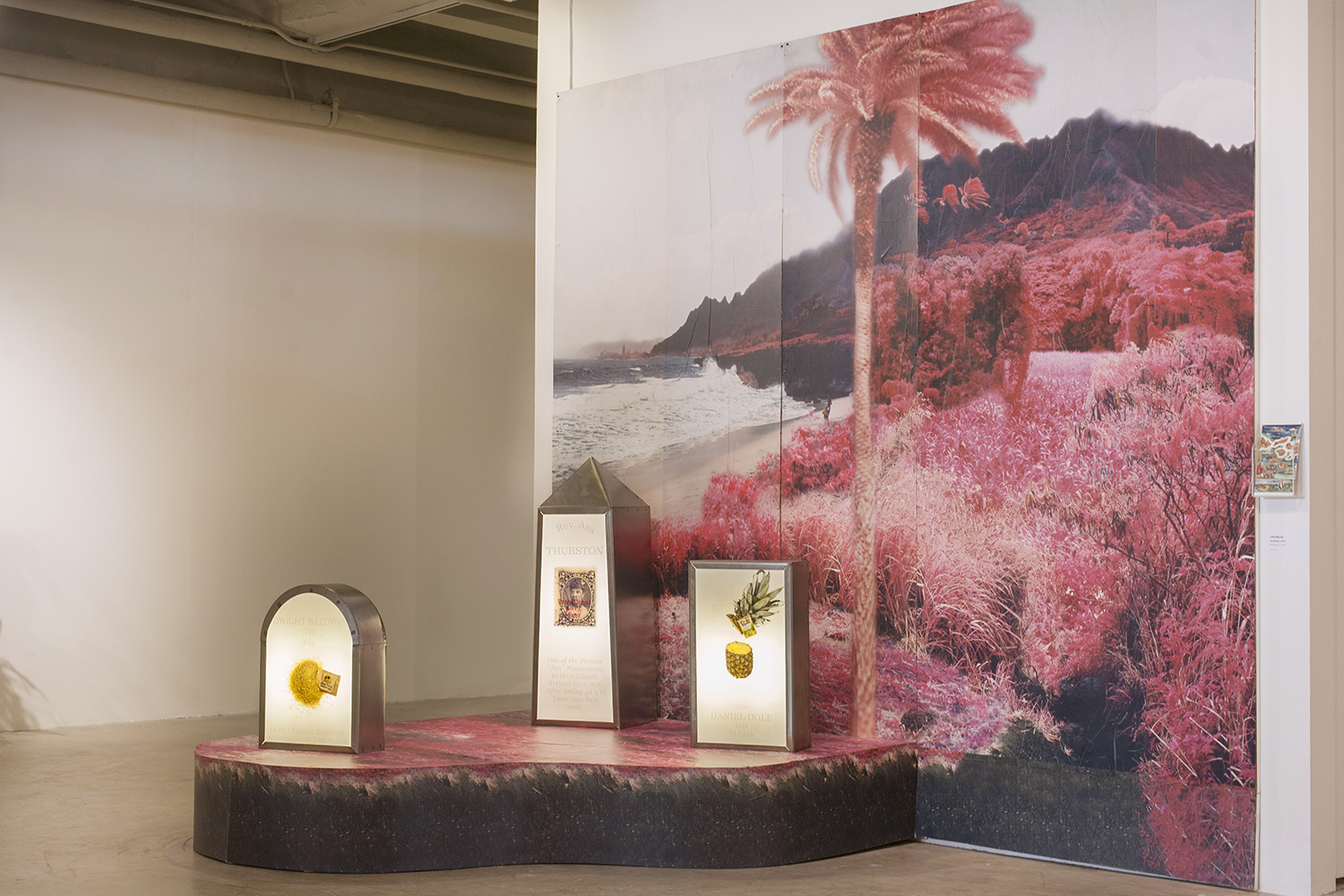Last Updated on 05/26/2018 by Joy Celine Asto
Kodak Aerochrome, the legendary infrared film that has mesmerized photographers with its surreal false colors, has also become instrumental in artist John Berner’s installations.
When Richard Mosse completed Infra in 2011, he probably didn’t expect that it would become one of the most celebrated works of photography, and inspire creatives to seek to paint their own works with its surreal color palette. It was all made possible by Kodak Aerochrome, the famous false color infrared film that needs no introduction. Mosse eventually became the photographer who catapulted the film to cult status, with many citing his work as the stimulus behind their own forays into the legendary emulsion.
Fast-forward to more recent times, we came across the art of Chicago-based John Berner, who combines photography and installation in his projects. One of his early works, Paradises, was actually his thesis for his Bachelor of Fine Arts degree, and was inspired by some of the photos he took in Hawaii using Kodak Aerochrome. We asked him to tell us more about how the idea for Paradises came about, as well as his discovery of the famed infrared film and the more recent snaps he shot with it.
Phoblographer: Can you tell us something about yourself and what you do?
John Berner: Hello, I’m John Berner, an artist hailing from the Pacific Northwest who moved out to Chicago several years ago to go back to school and finish my BFA, which I completed last year (thank you, thank you). My background as an artist started with film and video in the early 2000s, but I ended up changing career paths out of the arts shortly after. In 2008 I planned a trip to Japan, traveling outside the country for the first time since I was a kid. The day before leaving I was at a Goodwill and found an old Yashica SLR similar to the one I had grown up shooting with and decided to grab some film and pack it with me. It was pretty much a disaster with the messed up old camera, but what I had when I came back inspired me to really invest some time into still photography.
Several years later after I had gotten over my initial gear fetishization and got a good handle on the technical side of photography, I began to feel like I was making photos that were pretty, but mostly meaningless. I wanted more than pretty, and so I decided to go back to a capital A art school to try and dive into the possibilities of concept driven work. Four years later and my practice is still mainly photo based, but is also very directly tied into installation and sculpture as a cohesive whole to tell historical stories in ways that are more engaging. I’d hate to put anyone through the experience of reading my artist statement, so I’ll just say I like to research complicated histories of places and then try and present them in a way that might change traditional interpretations of them.
Phoblographer: Most people who have shot with the Kodak Aerochrome also shoot with film, whether regularly or occasionally. Is it also the same for you?
John: Yup. Having grown up in the early 90s I got started shooting film in mom’s camera as a kid. Which was probably one of my first creative endeavors. It was at least the first time that I took art making seriously in any way. It was also what got me back into photography after my trip to Japan, and what has always kept me engaged. I filled up a good three or four years shooting every camera and film stock I could get my hands on in every style of shooting I learned about. I Made sure I learned how to develop my own film, make my own prints, do wet-plate and other alternative processes. I even compiled a comprehensive database of several hundred film/developer/exposure comparisons with examples for online friends. By the end of it all though, I came to the conclusion that it comes down to the photographs themselves and what they represent. With experience, I’ve taken much more of a right tool for the right job approach. It’s way too easy to fetishize the film itself and fool yourself into thinking that the work is good because you shot it on film and enjoyed the process. I still intuitively reach for an old camera and some film when just out shooting, but when taking on a project now I definitely try and make sure I try and distance myself from the romanticized idea of film photography to just choose the right tool for the job at hand.
Phoblographer: How did you find out about Kodak Aerochrome, and where did you get your roll/s?
John: Like most people I learned about the film from Richard Mosse’s project in the Congo back in 2011. At the time I was pretty involved in the Flickr community and after doing some research found out that there was a guy named Dean Bennici who had just bought up the last fresh reels of the film and was starting to cut it down to 120 rolls. I bought a few rolls from him over the years as well as some sheets of 4×5 that he cut for me. Unfortunately, going back to school hampered my finances pretty heavily and I was shooting significantly less over the last few years while in school so I never really had the chance to seriously stock up. It sounds like he’s mostly tapped out by now, but I was able to get a large stack of scrap sheets from him after shooting this latest series that I should be able to shoot in 4×5 holders with a little finagling.

Phoblographer: We saw on your website that you’ve also worked with Kodak Aerochrome for one of your art projects called Paradises. Can you tell us something about it and how the idea came about?
John: Paradises was actually my thesis project for my BFA. The project started with the first few rolls of Aerochrome I had gotten from Dean back in 2011, I had been holding onto them for close to a year trying to figure out what I would shoot with them when two of my friends invited me to their wedding in Hawai’i. I figured what better way to use a super tropical exotic color palette than in Paradise. When I got back home though and developed the photos I loved them. They were beautiful and pristine and I rushed to put them out in the world and show them off. But over time I started feeling uncomfortable with them. They were so idealized and out of touch with the experience I had there. The Hawai’i I visited had flaws; it wasn’t some perfect paradise. I realized I had gone into the situation with a naive preconceived idea of what a tropical paradise should look like and how my candy colored film would suit it.
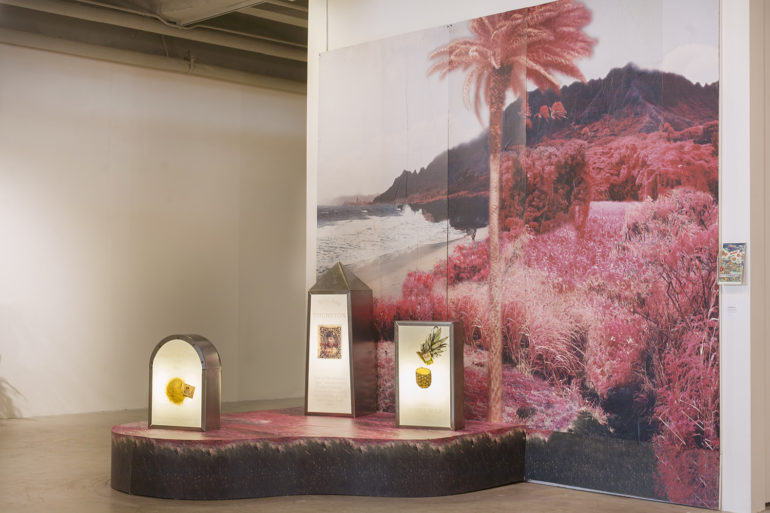

I was feeding into long held ideas of Hawai’i as an exotic bothered space. I didn’t want to be another white guy perpetuating those stereotypes, so I kind of just rejected the series as in poor taste and left it by the wayside. It wasn’t until I went back to school and dove into the conceptual side of the art that I decided I should go back and think about how those photos might be reworked. While I was starting to process these thoughts, Richard Mosse just happened to come to our school to do an artist talk and I was able to get onto a small panel of students for a roundtable Q and A. Sadly, instead of getting some insight into how to deal with the potential conflicts of using this specific film stock from someone with experience shooting explicitly contentious imagery, I was confronted with the realization that the person behind that well-known body of work didn’t seem to be thinking much at all about the problematic issues inherent in his work. Never meet your heroes, I guess. In the end, I at least came away from the experience committed to putting in the work to better understand the place I had photographed and turn those photos into something thoughtful and worthwhile.
I started doing research into the history of Hawai’i and in particular the history of American missionaries to the islands. I became fascinated with this transition of ideas. The ignorant idea the missionaries had about the “simple tropical savages,” and their perception of Hawai’ians as Adam and Eves in Eden waiting to be saved from their sinful ways, to the missionaries’ offspring seeing the island and its native population as an economic paradise waiting to be claimed.
What became apparent was that my concept of paradise that I had taken with me to the islands was based on a long history of colonizing, and in the case of Hawai’i, decades of very slick marketing and exoticizing for profit. The solution I came upon was reconciling these images’ bright extravagant nature by compositing them into one giant, over the top historical advertisement. I wanted to present a history of multiple concepts of paradise in the islands through visual mediums that had historically been used to establish and sell the very concept of paradise, in the form of agriculture, land, and eventually, tourism. I took the composited billboard and wheat-pasted it into a backdrop for lightbox advertisements in the shape of headstones of a few key American missionaries whose legacies would go on to shape the idea of a Hawai’ian paradise. Finishing it off was a tourist attraction leaflet that I gave out, providing a timeline of different events that shaped Hawai’ian history from the arrival of the missionaries. The Christian graves felt like a really effective tool for visualizing the exoticization of a specifally religious colonized space and using that to inform about a local, indigenous history that often gets brushed to the side. I felt like I had finally been able to reconcile the feelings of discomfort I had developed over time with the series of photos and could sort of close that chapter.
Phoblographer: Since Kodak Aerochrome is a pretty legendary film, did you make any special preparations or research prior to the shoot?
John: At the time that I got the film there really wasn’t a ton of information about it because it hadn’t been used widely in an artistic, conceptual way by many people yet. There just wasn’t much information tumbling around other than the standard Kodak spec. sheets. Most of what I learned was information directly from Dean or the few people on Flickr who had used Aerochrome. I decided to work as simply as possible. I got a B+W 099 filter (expensive at the time, but much easier to find than now) and just metered through it at 400 like I would a normal chrome and hoped for the best. It turned out that was all that was necessary. I don’t have the tools to measure actual IR levels which is what you’re exposing for, so I had to take stock of how hazy of a day it was, what time of day it was, what altitude I was at. All things that can determine how much IR radiation might be getting captured in those frames.
As far as doing some research online for IR indexes or anything like that, you could, but really I never felt the need to make things more complicated than necessary. Going into shooting Aerochrome a second time, I also knew I wanted as consistent as possible of a look to Paradises as I could, so I tried not to change things up too much. Biggest change I made was hand-checking all my rolls when passing through security this time. I lost about four frames by sending them through an x-ray on that first trip to Hawai’i and nearly wept.
Phoblographer: Lastly, please tell us something about the recent Kodak Aerochrome photos you shared with us. Are there any memorable or noteworthy stories/details about the shoot?
John: This recent group of photos actually came about from kind of a weird grouping of circumstances. I work as a preparator (art handler) for several places in the Chicago area, and this past Winter one of the companies that I occasionally do work for asked me out of the blue if I wanted to go work Art Basel Hong Kong. I had been out of school for roughly a year and had shot almost no photographs at all in that time. So I was kind of fiending to just make something. The fact that I had never been to Hong Kong and only really had illusory knowledge of the place made up of popular culture references (based on some pretty deeply entrenched colonialist sources) made me think it might be worthwhile to open up another avenue for the body of work in Paradises that I had assumed I was finished with.
The problem with trying to recreate something you’ve done out of ignorance though, is the second time you do it you’re going in with completely different intentions. I had shot that first group of photos without any idea of what they would become down the road. With this trip I knew that I was going in with a critical eye and a template I had already established. The only thing then that I could really do was try to keep myself as free as possible from the bias of the Hong Kong I held in my mind. I only looked up the most basic of tourist information, I rewatched the terrible 80s mini series “Noble House” that was then my largest source of supposed information about Hong Kong, and when I got there I just tried to experience the place and feel out what I thought would be the right images to collect as I was going.




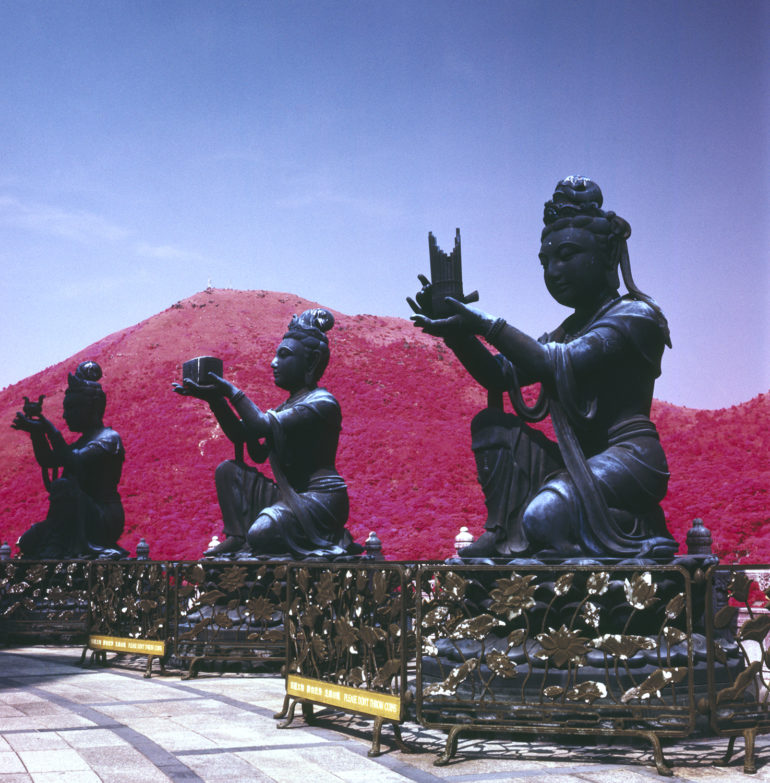
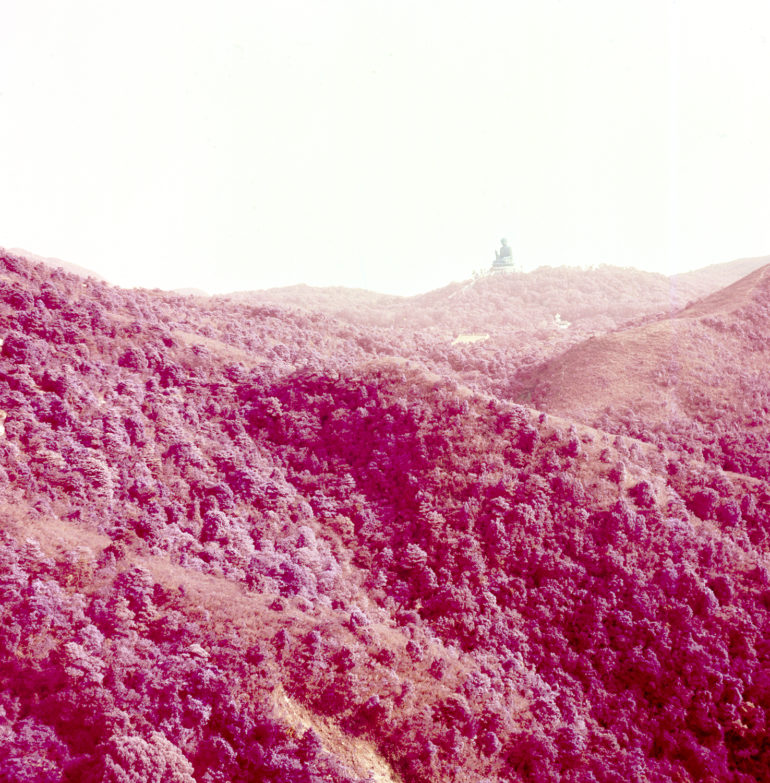
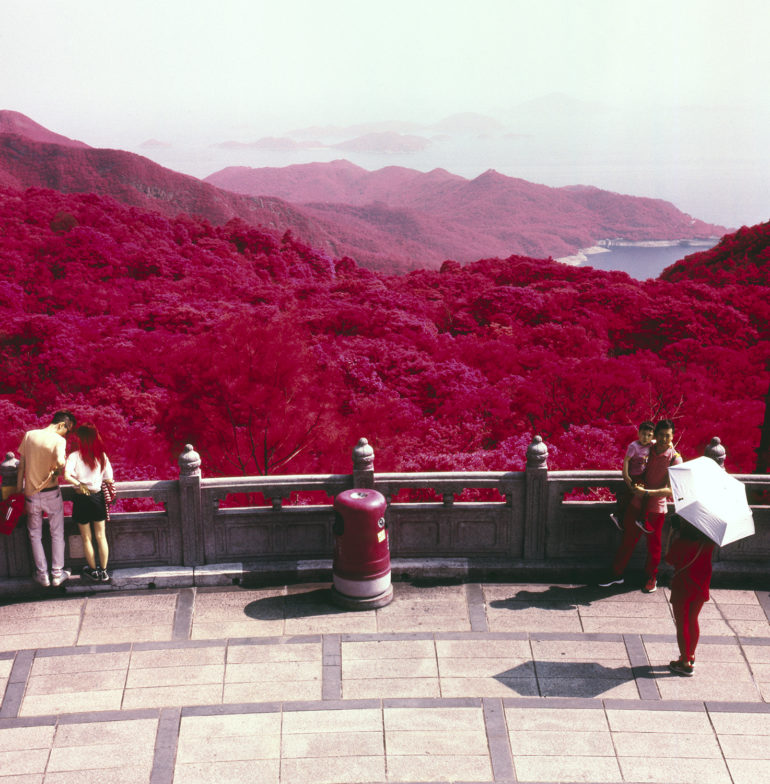
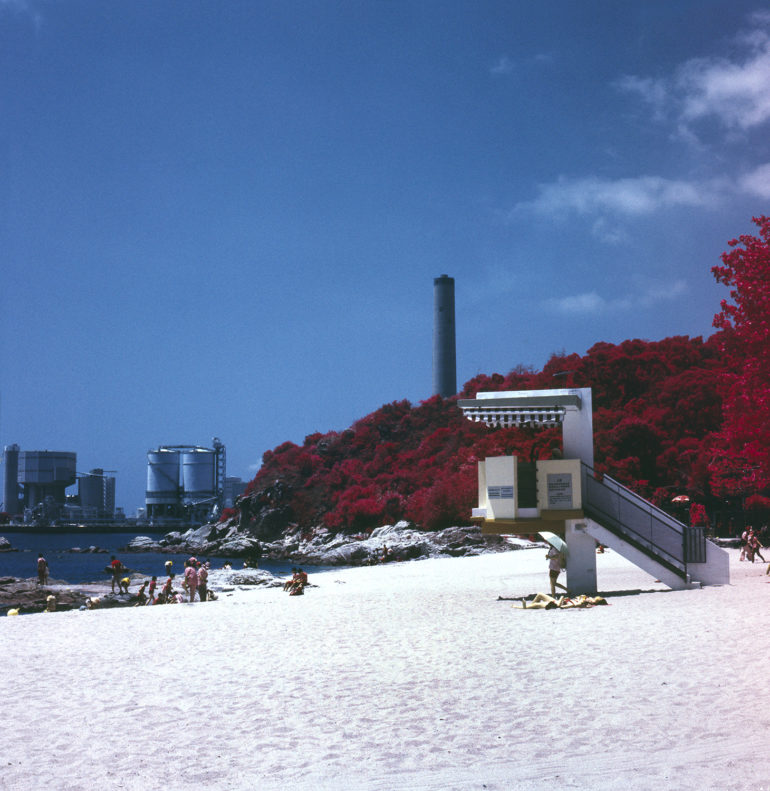
Having only two rolls left, though, I knew I would have to be a bit more judicious with my exposures and knowing that they would eventually be composited this time was definitely helpful in carefully choosing what to shoot in order to let me craft that final installation. It means that there are fewer actual photos that I would say stand alone on their own or will be shown in that way, but it also means that I think the final work will be stronger. In the end though, it’ll come down to the research that I do to really set in stone what this body of work eventually becomes. Which I think is one of the best parts of having taken the path that I have in my practice.
I used to find a quirky film stock or camera, go out and take some pretty pictures, scan, and maybe print them, and then I was done. Now, because of this unsettling reaction I had to this film stock and the way I had used it, getting those photos taken and sitting in front of me is just the first step to something much bigger. I get to spent even more time learning about the histories that I missed while shooting the photos and working through how I can reframe those stories for a new audience. In the end, being able to learn more about the people and the places I’ve taken for granted becomes even more gratifying.
Visit John Berner’s website to see more of his art, and check out other interviews we did with photographers Ryan Struck and Dan Zvereff, who also shot with Kodak Aerochrome.


